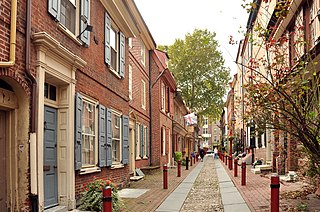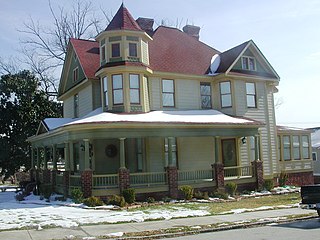
Waynesville is the county seat of Haywood County, North Carolina. It is the largest town in North Carolina west of Asheville. Waynesville is located about 30 miles (50 km) southwest of Asheville between the Great Smoky and Blue Ridge Mountains.

Fletcher Place is a historic district and neighborhood in the city of Indianapolis, Indiana named after Calvin Fletcher, a prominent local banker, farmer and state senator.

Historic districts in the United States are designated historic districts recognizing a group of buildings, archaeological resources, or other properties as historically or architecturally significant. Buildings, structures, objects, and sites within a historic district are normally divided into two categories, contributing and non-contributing. Districts vary greatly in size and composition: a historic district could comprise an entire neighborhood with hundreds of buildings, or a smaller area with just one or a few resources.

In the law regulating historic districts in the United States, a contributing property or contributing resource is any building, object, or structure which adds to the historical integrity or architectural qualities that make the historic district significant. Government agencies, at the state, national, and local level in the United States, have differing definitions of what constitutes a contributing property but there are common characteristics. Local laws often regulate the changes that can be made to contributing structures within designated historic districts. The first local ordinances dealing with the alteration of buildings within historic districts was enacted in Charleston, South Carolina in 1931.

College Hill is a neighborhood in the west central section of the United States city of Greensboro, North Carolina. College Hill was Greensboro's first neighborhood.

Boylan Heights is a historic neighborhood in Raleigh, North Carolina. It was added to the National Register of Historic Places as a historic district on July 29, 1985. It is also one of six local Historic Overlay Districts in Raleigh.

Greeneville is a neighborhood of the city of Norwich, Connecticut, located northeast of downtown Norwich along the west bank of the Shetucket River. Most of the neighborhood is designated Greeneville Historic District, a historic district that is listed on the National Register of Historic Places.

The Roanoke Park Historic District a national historic district located at Raleigh, North Carolina. It is one of the city's historic Five Points neighborhoods and encompasses 446 contributing buildings and 1 contributing site. It is situated southeast of the Five Points intersection of Glenwood Avenue and Fairview and Whitaker Mill Roads. Roanoke Park is composed of six separate plats, filed from 1913 to 1926, and is roughly shaped like a diamond.

The Canton Main Street Historic District is a national historic district located at Canton, Haywood County, North Carolina. It includes 34 contributing buildings and one other contributing structure and includes architecture by Benton & Benton. It includes Early Commercial architecture and Late 19th and 20th Century Revivals architecture. Located in the district is the separately listed Colonial Theater. Other notable buildings include the P L & S Building (1932), Champion Fibre Company Office Building (1918), Champion Bank and Trust, Imperial Hotel, and the former United States Post Office (1939).

Jonesboro Historic District is a national historic district located at Morganton, Burke County, North Carolina. It encompasses 35 contributing buildings and 1 contributing site in historically African-American neighborhood of Morganton. The primarily residential buildings were built between about 1895 and 1935. It includes representative examples of Bungalow / American Craftsman and Shotgun style architecture.
Union Street North–Cabarrus Avenue Commercial Historic District is a national historic district located at Concord, Cabarrus County, North Carolina. The district encompasses 14 contributing buildings in the central business district of Concord. It primarily includes commercial buildings in popular architectural styles including Beaux-Arts style architecture. Located in the district are the Bell and Harris-Maxwell Brothers Furniture Store (1921–1924), Yorke and Wadsworth Company Warehouse (1908–1911), Lippard and Barrier Grocery (1908–1911), Concord National Bank and Hotel Concord (1926), Star Theatre, Cannon Building and Concord Theatre, and Horton Building–Commerce and Merchants Building (1952).

Fisher Park Historic District is a national historic district in the Fisher Park neighborhood, Greensboro, Guilford County, North Carolina. The district encompasses 541 contributing buildings, 2 contributing sites, and 44 contributing structures in a predominantly residential section of Greensboro. The houses were largely built between the 1900s and 1930s and include notable examples of Queen Anne, Colonial Revival, Gothic Revival, American Foursquare, and Bungalow / American Craftsman-style architecture. Located in the district are the separately listed Dixon-Leftwich-Murphy House, John Marion Galloway House, Julian Price House, and Latham-Baker House. Other notable buildings include the First Presbyterian Church (1928), Holy Trinity Episcopal Church (1922), Gant-McAlister House, and A.J. Schlosser House.

South Greensboro Historic District, also known as the Asheboro Street Historic District, is a national historic district located in the Southside neighborhood, Greensboro, Guilford County, North Carolina. The district encompasses 327 contributing buildings, 1 contributing site, 10 contributing structures, and 1 contributing object in a predominantly residential section of Greensboro. The houses were largely built between the 1870s and the 1930s and include notable examples of Queen Anne, Italianate, American Foursquare, and Bungalow / American Craftsman-style architecture. Notable buildings include the Atkinson House, Hanner House, B.E. Jones House, T. Bernard House, C.O. Younts House, W.S. Witherspoon House, and R. N. Watson House, former Asheboro Street Church, and Nettie Mae Coad Apartments.

Academy Hill Historic District is a national historic district located at Statesville, Iredell County, North Carolina. It encompasses 40 contributing buildings in a mixed-use neighborhood of Statesville. The district includes notable examples of Late Victorian architecture including primarily brick educational and industrial buildings and one and two-story frame dwellings. They were mainly built between 1885 and 1930. Notable buildings include the former Statesville Male Academy (1874), Statesville Graded School (1892), J. C. Steele & Sons Brick Machinery Plant, Ash Tobacco Factory, O. W. Slane Glass Company, J. C. Steele House (1880s), C. M. Steele House (1901), H. Oscar Steele House, and William E. Webb House.

Jackson Historic District is a national historic district located at Jackson, Northampton County, North Carolina. The district encompasses 168 contributing buildings, 2 contributing sites, 1 contributing structure, and 2 contributing objects in the central business district and surrounding residential sections of Jackson. The district developed between about 1825 and 1953 and includes notable examples of Federal and Greek Revival style architecture. Located in the district are the separately listed Amis-Bragg House, Church of the Saviour and Cemetery, and Northampton County Courthouse Square. Other notable contributing resources include Lewis Drug Store (1930), Kennedy's Five Cents to Five Dollars Store, Bank of Northampton (1928), Bowers Hardware Store, Atlas Oil Company Building, Farmer's Cotton Gin Complex, Faison House, Saint Catherine's Hall (1848), Judge Robert Peebles House (1890s), Selden-Boone House, Jackson Baptist Church (1881), and Jackson United Methodist Church (1937).

Salisbury Railroad Corridor Historic District is a national historic district located at Salisbury, Rowan County, North Carolina. The district encompasses 37 contributing buildings and 1 contributing site consisting primarily of railroad-related and commercial buildings. It largely developed during the first half of the 20th century, and includes notable examples of Mission Revival style architecture. Located in the district is the separately listed Salisbury Southern Railroad Passenger Depot designed by Frank Pierce Milburn. Other notable buildings include the Cheerwine/Carolina Beverage Corporation Building (1913), Yadkin Hotel (1913), Frick Building, Boyden-Overman Company Cotton Warehouse, and Old Freight Depot.

Laurinburg Commercial Historic District is a national historic district located in Laurinburg, North Carolina. The district encompasses 51 contributing buildings and 2 contributing structures in the central business district of Laurinburg.

Longview Gardens Historic District is a historic post-World War II neighborhood and national historic district located 1+1⁄2 miles east of downtown Raleigh, North Carolina. The district encompasses 189 contributing buildings and five contributing sites. Notable contributing resources include the Raleigh Country Club golf course designed by Donald Ross, Longview Baptist Church and Milner Memorial Presbyterian Church (1946), both striking examples of Modernist architecture.

Mordecai Place Historic District is a historic neighborhood and national historic district located at Raleigh, North Carolina. The district encompasses 182 contributing buildings and 1 contributing object in the most architecturally varied of Raleigh's early-20th century suburbs for the white middle-class. Mordecai Place was listed on the National Register of Historic Places in February 1998, with a boundary increase in 2000.

The Sand Hills Historic District in Augusta, Georgia is a historic district which was listed on the National Register of Historic Places in 1997. The district included 334 contributing buildings and a contributing site in a 231 acres (0.93 km2) area roughly bounded by Monte Sano and North View Aves., Mount Auburn St., Johns Rd., and the Augusta Country Club.























